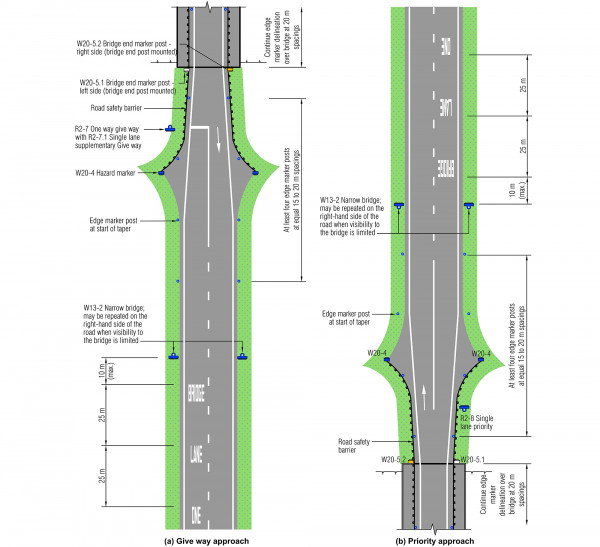Signs for one-lane bridges should include R2-7 One way give way signs which may be used in conjunction with R2-7.1 Single lane supplementary Give Way signs and used to indicate directional priorities at single lane bridges or sections of single lane roadway (a single lane situation exists when the trafficable width of a bridge or roadway is 5.0m or less). Such signing indicates the required actions of drivers when vehicles are simultaneously approaching a single lane bridge (or section of single lane roadway) from each direction.
The primary objective is to alert drivers to a potentially dangerous head on type situation and place the responsibility onto the drivers to be prepared to stop and give way.
Further work is currently being undertaken in relation to signs for “one-lane bridges”. This work is being carried out in response to consultation feedback on Part 5 of the TCD manual and the potential need to identify future sign formats associated with one-lane bridges.
Watch this space, an update will be coming.
Table 6‑7 should be used to determine the sign is required for one-lane bridges. For specific sign, details such as size and symbol height refer to the Sign specifications.
Table 6‑7: Signs for one-lane bridges
|
Sign code |
Example |
Description/use |
|---|---|---|
|
W13-2 Narrow bridge |
|
A W13-2 sign should be installed on each approach in advance of the single lane section. Where the single lane section of roadway is not a bridge, W13-1.1 should be used. For sign location, refer to notes 1 and 2 below. |
|
R2-7 One way give way R2-7.1 Single lane supplementary Give way |
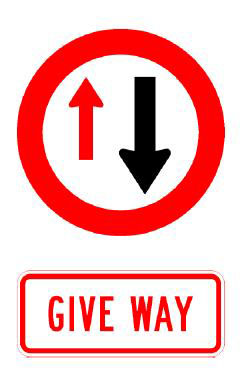 |
An R2-7 sign should be located on the approach considered most appropriate for give way control or whichever approach has the least sight distance. The sign must be located at or near the bridge abutment (or single-lane roadway section) in such a position as to be clearly visible to approaching road users as they scan the road ahead. Normally the sign would be installed on the left side of the approach but in some situations where the single lane section is immediately preceded by a sharp left-hand bend, consideration should be given to installing the sign on the right-hand side to ensure optimum viewing of the sign by approaching road users. The R2-7 sign may be supplemented with an R2-7.1 supplementary give way sign. For sign location, refer to notes 1 and 2 below. |
|
R2-8 Single lane priority |
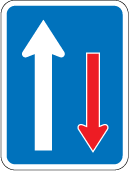 |
An R2-8 sign should be located on the approach considered most appropriate for priority or whichever approach has the most sight distance. The sign must be located at or near the bridge abutment (or single-lane roadway section) in such a position as to be clearly visible to approaching road users as they scan the road ahead. Normally the sign would be installed on the left side of the approach but in some situations where the single lane section is immediately preceded by a sharp left-hand bend, consideration should be given to installing the sign on the right-hand side to ensure optimum viewing of the sign by approaching road users. An R2-8 sign should not be installed in combination with any other signs. For sign location, refer to notes 1 and 2 below. |
Table 6‑7 notes:
|
Operating speed |
Distance |
|---|---|
|
50km/h |
65m |
|
70km/h |
100m |
|
80km/h |
120m |
|
90km/h |
140m |
|
100km/h |
160m |
The establishment of priorities for signing single lane bridges (or roadway) requires careful consideration of several factors, including but not limited to:
Continuous centre-lines should be marked on the sealed roadway approaches to one-lane bridges when the entry/departure roadways are marked as two-lane two-way roads.
Centre-lines should be marked as shown in Table 6‑8.
Table 6‑8: Centre-line marking standards for the approaches to one lane bridges
|
Colour |
Reflectorised white |
|---|---|
|
Width |
100mm minimum |
|
Stripe |
Continuous |
|
Gap |
N/A |
|
Length |
Minimum: 20m; Desirable: ≥30m (urban), ≥50m (rural) |
A centre-line should be marked from the point where the width of the approach roadway is at least 5.1m, and desirably 6.0m, to allow opposing traffic to pass. A centre-line should not be marked where the roadway width is less than 5.1m.
Sealed roadways forming the approaches to one-lane bridges should have edgelines marked as shown in Table 6‑9.
The edgelines shall form a taper on the sealed roadway approach to one-lane bridges, from the edges of seal or edgelines to the bridge roadway width. Edgelines should normally terminate just clear of the kerbs at the end of one-lane bridges, but they may be continuous over bridges where there is sufficient width to effectively mark and maintain lines.
Table 6‑9: Standard marking requirements for edgelines at one lane bridges
|
Colour |
Reflectorised white |
|---|---|
|
Width |
100mm minimum |
|
Stripe |
Continuous |
|
Length |
50m minimum |
|
Location |
Should form a taper on the sealed roadway approach to a one-lane bridge, from the edges of seal or edgelines to the bridge roadway width. Should normally terminate just clear of the kerbs at the ends of one-lane bridges but may be continued over bridges where there is sufficient width to mark and maintain the lines. |
Where a two-lane two-way sealed approach to a one-lane bridge is controlled by an R2-7 One way give way sign and an R2-7.1 Single lane supplementary Give Way sign (if installed), it should be marked with a single white holding line marking (see Part 4 of the TCD Manual). The holding line is only to indicate where vehicles should stop when giving way and has no legal significance. The holding line should be marked as described in Table 6‑10.
Table 6‑10: Specification for holding line markings for one-way bridges
|
Colour |
Reflectorised white |
|---|---|
|
Width |
300mm minimum |
|
Stripe |
Continuous |
The holding line should be marked at the point where the width of the approach roadway is at least 5.1m, and desirably 6.0m, to allow opposing traffic to pass.
Holding lines on sharply curved bridge approaches should be located to allow for the swept path requirements of vehicles likely to be using the road rather than the roadway width requirements noted above.
The words "ONE", "LANE", and "BRIDGE" should be marked on sealed roadway approaches to one-lane bridges. Refer to Figure 6‑4 for the arrangement of the road messages and refer to Table 6‑11 for specification of the markings.
Table 6‑11: Specification for character road markings at one-lane bridges
|
Colour |
Reflectorised white |
|---|---|
|
Length |
2.4m in urban areas 3.6m in rural areas |
A straight-ahead arrow should be used on the departure side of one-lane bridges to remind road users that they should travel on the left. Care should be taken when locating a keep left reminder arrow near an intersection to ensure that the arrow does not mislead. In some cases, it may be appropriate to repeat keep left reminder arrow in each lane further beyond the bridge to reinforce to road users that they should travel on the left (refer also to keep left reminders for information on keep left reminder arrows).
Figure 6‑4: Marking and signage requirements for one-lane bridges for give way and priority approaches
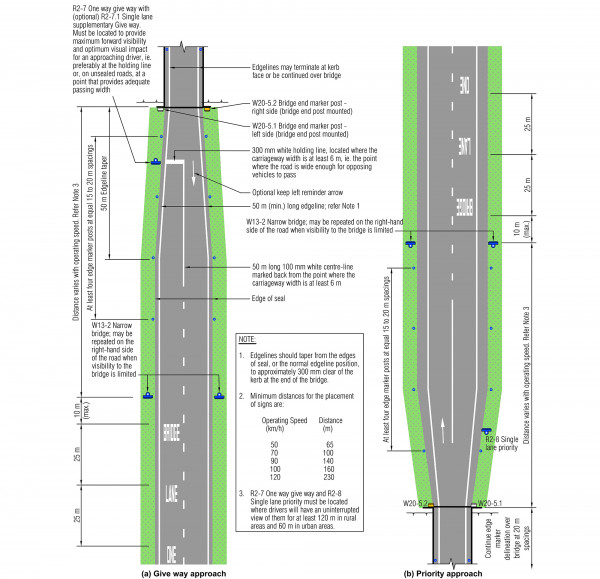
Figure 6‑5: Road markings and delineation at one-lane bridges (refer also to Figure 6‑4 for other notes)
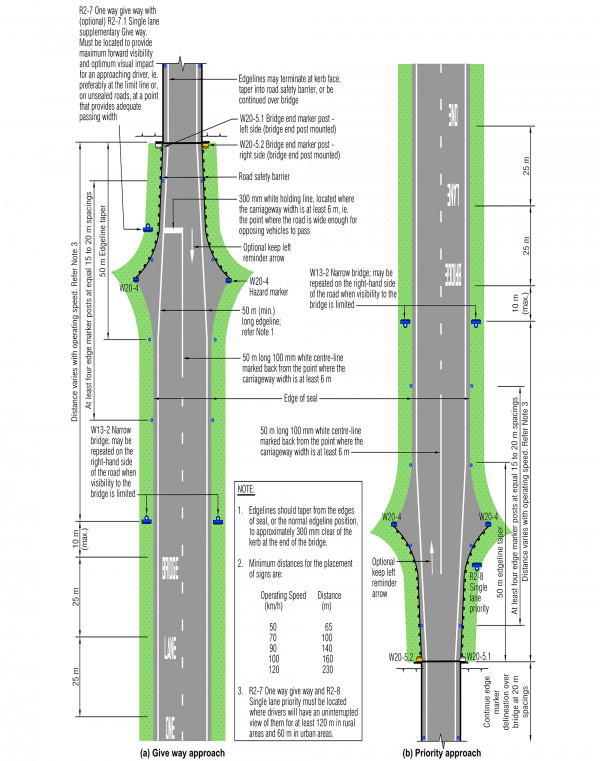
View larger image [JPG, 1.1 MB]
Figure 6‑6: Road markings and delineation at one-lane bridges (Refer also to Figure 6‑4 for other notes)
